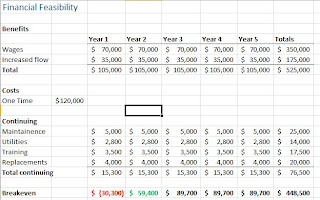Once the problem is identified, the search begins for ways to solve the problem. There are always multiple solutions available. Typically there is a minimal, least expensive solution, which fulfills the core requirements for a project but doesn't provide any extra or desireable features. It may also be less scalable and customizable and have a shorter projected life.
On the other end, there is a solution that provides all the requirements and all the bells and whistles. It is usually scalable and customizable and has a longer expected life, but is expensive. Then, of course, there are all the solutions that fall between these two.
Alternate solutions are not always a choice of relative expense, they can also be choices between technologies, between open source and Microsoft's managed code, for instance, between Sql Server and Oracle or an open sorce database, etc.
Feasibility
Each alternate solution should be analyzed for feasibility.
There several kinds of feasibility: First is financial. Will the project pay for itself? Will it ever recoup its cost. Below is a simple financial analysis of a project.

Other kinds of feasibility include, cultural, technical, time, and legal.
Cultural feasibility has to do with the culture of the company and its customers. Some changes go against the culture of a company and won't be successful no matter how good the technology. THey will only breed resistance and failure.
Technical feasibility has to do with whether the technology is avaialable and practical. It also has to do with whether the company has the means to support and maintain the technology.
Time feasibility has to to with whether the project can be completed within the projected timeline
Legal feasibility has to do with any relevant laws, copyrights and patents. It can also include safety rules and union contracts.
Below is a picture of a spreadsheet that can be used to help decide between alternatives. It uses a weighted average. The clients list the major requirements and features they would like to see the project embody. Then they provide percentages for how important each component is to the project. The total percents should add up to 100. They they rate each alternative solution on some scale. (the example uses 1 to 5). The rating is multiplied with the percent to get the weight. The weights are totaled. The heighest weight should be your best bet.

No comments:
Post a Comment